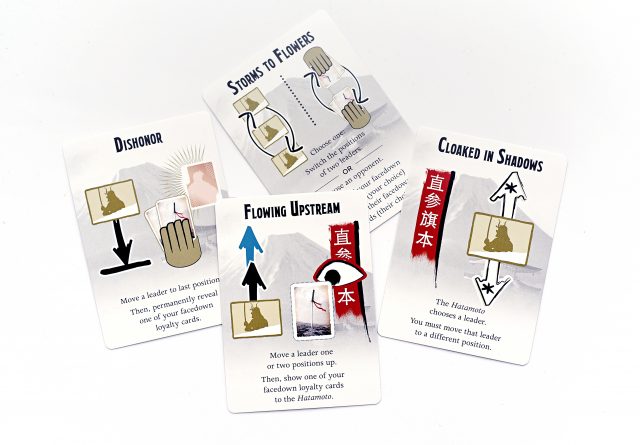I first played a little game called Minuscule many years ago. On first impression, I wasn’t too thrilled with it. It seemed like a pretty simple kids game about racing insects. I shelved it and didn’t bring it out again until my nephew visited and we pulled it out. That weekend we must’ve played Minuscule a dozen times. The fun of secret goals, chaotic movements, and simple gameplay become manifest. It has since become a family favourite and one of my go to games with larger numbers or newer players. Why am I talking about a bug racing game in a review about a game set in Japan with warring clans fighting for the right to succeed the Shogun? Well, the two are strikingly similar in mechanics. It’s not a bad thing per se, especially considering how high I am on Minuscule.
 In Shogunate, players are secretly loyal to one or two clans looking to become the next Shogun. Over a series of rounds, they will attempt to secure the line of succession to the Shogun and earn Honour for their clans’ placement at the end of the round. The goal is to earn 12 Honour points and the first player to do that will earn their place as the next Shogun.
In Shogunate, players are secretly loyal to one or two clans looking to become the next Shogun. Over a series of rounds, they will attempt to secure the line of succession to the Shogun and earn Honour for their clans’ placement at the end of the round. The goal is to earn 12 Honour points and the first player to do that will earn their place as the next Shogun.
Each player has a set of six Action cards. Each of the six Clans has two Loyalty cards. At the start of the first round players are dealt two Loyalty cards face down. These are the ones they will be loyal to for the game, and attempt to earn Honour for. It’s possible that a player will get two of the same Clan Loyalty cards, meaning they’ll have less options for victory, but at least be able to focus their efforts.
Rounds begin by creating a line of succession with the six different clans. A Shinobi marker is placed on the third Clan in the line of succession (wherever the Shinobi is at the end of the round will cost that Clan points). A Plot deck is created, revealing the top card (this determines where players want to position their Clan to earn Honour, and what actions will occur at the end of the round).
One player in chosen as the Hatamoto (a Samurai under the direct command of the Shogun) for the round. Each other player will secretly select an Action card, and once everyone is ready reveal them. Then the Actions are resolved. The trick is that the Hatamoto will decide which order they are resolved in.
 Action cards rearrange the line of succession. The Dishonour card allows a player to select one leader and send them to the end of the succession line, then forces them to reveal one of their Loyalty cards. The Path of the Arrow allows a player to move a leader one space up on the succession line then is allowed to see one of the Loyalty cards of another player. Cloaked in Shadows allows the Hatamoto to select a leader, then the active player moves it to a different place in the line of succession.
Action cards rearrange the line of succession. The Dishonour card allows a player to select one leader and send them to the end of the succession line, then forces them to reveal one of their Loyalty cards. The Path of the Arrow allows a player to move a leader one space up on the succession line then is allowed to see one of the Loyalty cards of another player. Cloaked in Shadows allows the Hatamoto to select a leader, then the active player moves it to a different place in the line of succession.
The order the Actions are resolved (obviously) makes a big difference in the final line. Players are, of course, trying to move their Clans into positions where they can earn the most Honour. However, it will be the Hatamoto who will have the most control as to how the cards affect the line.
Keeping their loyalties secret as long as possible, gives players a little more control towards earning Honour. The more obvious they are with their actions, or if they are forced to reveal their Loyalty cards, other players will have more ability to slow down their political aspirations.
Once all of the actions have been executed, the Leaders receive Honour tokens based on their positions indicated by the Plot card. Then the Hatamoto performs the Plot ability indicated by the card. Wherever the Shinobi has ended up, the Leader loses one point of Honour. Next, players check for the end of the game. If any one player has a sum of 12 Honor points between the two Loyalty cards they have, they win the game. If no player has won yet, the player to the left of the Hatamoto becomes the new one, a new Plot card is revealed, and another round is played.
 If there is a tie, the player with the Leader closest to the front of the line of succession breaks the tie. If ties persist much past that, the rulebook suggest players resort to a sword fight to the death to determine the winner. With my friends, we just house ruled a shared victory, but to each their own.
If there is a tie, the player with the Leader closest to the front of the line of succession breaks the tie. If ties persist much past that, the rulebook suggest players resort to a sword fight to the death to determine the winner. With my friends, we just house ruled a shared victory, but to each their own.
With up to six players vying for control of the political system, Shogunate can be a bit chaotic at times, but it’s fun to see the strategies play out. Adrienne Ezell has come up with a compelling struggle for power, that is fun and doesn’t outstay its welcome. Although, I don’t think it will replace Minuscule in my library, I really enjoyed this one.
Thank you to Action Phase Games for providing a review copy of Shogunate.
Comments
No comments yet! Be the first!